-
Sen. Rubio proposes that Congress, not DHS, devise border security plan
Senator Marco Rubio (R-Florida), a member of the bipartisan group which drafted the immigration bill which passed the Senate Judiciary Committee and which will be brought to the floor of the Senate next week, is working on a proposal which will dramatically change the approach to devising and assessing border security in the bill. The bill now has DHS entrusted with the responsibility of devising a border security plan and determining whether the plan has been adequately implemented. Rubio proposes that Congress would assume these responsibilities, saying that the current plan for borer security is not robust enough to convince many Republican lawmakers to support the immigration bill.
-
-
Texas Senate bans using drones to take photos, videos without subjects’ permission
Last Sunday the Texas State Senate passed, by a 26-5 vote, a law banning citizens from using drones to take photographs or videos. The legislation will make using a drone to take photos or videos of people without their permission a Class C misdemeanor, which could lead to a $500 fine. Distributing photos or videos taken from a drone will be a Class B misdemeanor, and civil liabilities could add up to $10,000.
-
-
Firefighters, FAA weighing the use of drones for wildfires
With the wildfire season already claiming land and homes in the Western United States, federal government firefighters are considering the use of drones outfitted with cameras to map out the size and speed of a wildfire.
-
-
New Obama policy sets higher standards for drone use
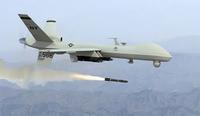
In a major policy speech Thursday, President Obama announced plans to set higher standards for the use of drones in the fight against terrorists. He defended the use of the unmanned vehicles in that war, however, including when, in extreme situations, they are used to kill American citizens.
-
-
Master “remote” control for all military unmanned systems
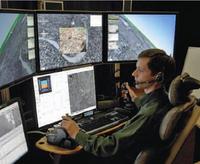
Historically, unmanned systems have been developed and fielded as individual items built by different vendors, which has led to increased spending, from $284 million in 2002 to more than $3 billion in fiscal year 2010. Researchers have developed something similar to a master remote control for separate components of differing brands of entertainment systems: it is called the Common Control System, and it will control military ground, air, and undersea unmanned systems across the services.
-
-
Central Washington State proposed for a UAV research and testing site
The FAA Modernization and Reform Act of 2012 enacted by Congress calls for establishing six unmanned aircraft system research and testing sites in the United States. A consortium of Washington State-based organizations will soon submit the final section of a proposal to site an unmanned aircraft system research and testing facility in central Washington. If successful, the proposal to the Federal Aviation Administration (FAA) will result in the FAA naming the Pacific Northwest Unmanned Aerial Systems Flight Center as one of six U.S. testing facilities later this year.
-
-
Immigration reform conditioned on border being secured by unmanned vehicles
Between 2006 and 2011, CBP spent $55.3 million on drone use and maintenance operations, according to a DHS Inspector General (IG) report. The IG recommended that the agency stop buying drones because the aircrafts are costly to maintain and have flown significantly less than their predicted flight times. The bipartisan immigration proposal drafted by the bipartisan Gang of Eight includes a provision which would create a 24/7 border surveillance system heavily dependent on the use of drones.
-
-
Critics say drones make little contribution to border security
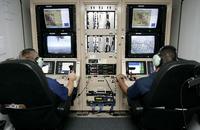
A new report says that U.S. Customs and Border Protection (CBP) drones are a wasteful giveaway to defense contractors and a threat to civil liberties. The report cites CBP own figures, the contribution drones make to border security is minimal. According to CBP calculations, drones have played a role in only 0.003 percent in drug seizure and 0.001 percent in illegal border crossing apprehensions.
-
-
DHS-funded police gear blurs line between crime-fighting and war-fighting
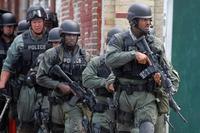
DHS is funding the purchase of military gear by Bay Area police departments. Critics of the program say the money allocated for the war on terror is blurring the line between local law enforcement focusing on crime fighting and soldiers fighting in an enemy war zone.
-
-
California city could become first in the state to ban drones
The City Council in Rancho Mirage, California was set to vote yesterday on a proposal which would ban the use of drones in residential areas in the city. If it passes, it will be the first law of its kind in the state. The ordinance would ban the flying of “unmanned aircraft that can fly under the control of a remote pilot or by a geographic positions system (GPS) guided autopilot mechanism” up to 400 feet above areas that have been zoned residential.
-
-
British public divided on merits of drone strikes
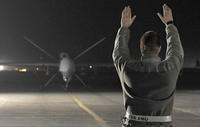
Fifty-five percent of the British public would support the U.K. government assisting in a drone missile strike to kill a known terrorist overseas, but support drops substantially if innocent casualties are likely, according to a new study.
-
-
FAA gives Arlington, Texas police permission to use UAVs
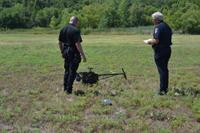
The Federal Aviation Administration (FAA) has given the Arlington (Texas) Police Department permission to use two small helicopter UAVs. The FAA did lay out a set of rules for the police department to follow when using the drones.
-
-
Obama wants U.S. to influence debate over global drone rules
President Barack Obama wants the United States to help formulate global guidelines for the use of drones, especially as other countries, led by China, have begun to invest in their own drone fleets.
-
-
Enabling small ships to launch and retrieve long-endurance UAVs
About 98 percent of the world’s land area lies within 900 nautical miles of ocean coastlines. Enabling small ships to launch and retrieve long-endurance UAVs on demand would greatly expand the U.S. military’s situational awareness and ability quickly and flexibly to engage in hotspots over land or water. DARPA is seeking companies to develop these systems.
-
-
Ohio country authorized to use drones to look for missing persons
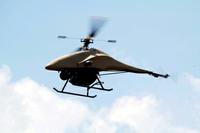
The Medina County, Ohio, Sheriff’s Office has recently been authorized to fly drones on police missions. Tom Miller, the county’s new sheriff, said the drones will be used specifically for looking for missing people or suspect who may be hiding in the woods.
-
- All
- Regional
- Water
- Biometrics
- Borders/Immig
- Business
- Cybersecurity
- Detection
- Disasters
- Government
- Infrastructure
- International
- Public health
- Public Safety
- Communication interoperabillity
- Emergency services
- Emergency medical services
- Fire
- First response
- IEDs
- Law Enforcement
- Law Enforcement Technology
- Military technology
- Nonlethal weapons
- Nuclear weapons
- Personal protection equipment
- Police
- Notification /alert systems
- Situational awareness
- Weapons systems
- Sci-Tech
- Sector Reports
- Surveillance
- Transportation
Advertising & Marketing: advertise@newswirepubs.com
Editorial: editor@newswirepubs.com
General: info@newswirepubs.com
2010-2011 © News Wire Publications, LLC News Wire Publications, LLC
220 Old Country Road | Suite 200 | Mineola | New York | 11501
Permissions and Policies
Editorial: editor@newswirepubs.com
General: info@newswirepubs.com
2010-2011 © News Wire Publications, LLC News Wire Publications, LLC
220 Old Country Road | Suite 200 | Mineola | New York | 11501
Permissions and Policies
